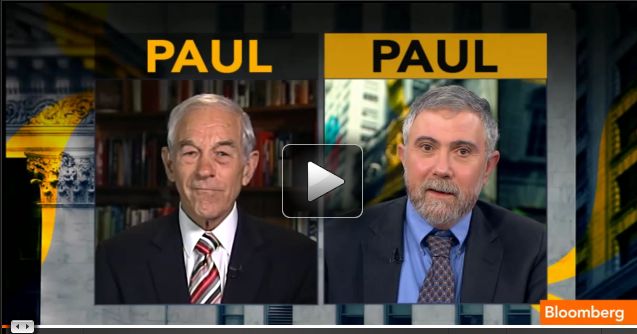News that severe inflation has arrived in the US — well beyond the Federal Reserve target of 1.5 to 2 percent — continues to abound. The latest Everyday Price Index from the American Institute for Economic Research even contends that prices for frequent purchases are now rising at a 23 percent annual rate.
Given immense federal deficits and almost zero percent interest rates, this trend was predictable. However, some individuals, including Nobel Laureate Paul Krugman, want even more inflation! If you haven’t seen it, you ought to check out his debate with Republican presidential candidate Ron Paul, who noted that empires through the ages have tried and failed with such chicanery.
But rather than simply dismiss outright such calls for more government spending via the printing press, one does better to at least clarify why the prevailing approach is problematic.
The textbook problems with inflation are shoeleather and menu costs. In other words, accommodating for inflation is a cost in and of itself. People waste time and energy spending rapidly and using their money before it loses value — shoeleather costs — and they must change and renegotiate contracts with greater frequency — menu costs.
These two costs, though, only scratch the surface. Most importantly, devaluation of a currency is a concealed tax, as the Platte Institute noted in a recent article. The generation of more currency simply means the currency already in circulation is of less value.
That means a tax on all those who use the currency, and in the case of the U.S. dollar it includes people in other countries such as Panama and Ecuador. I shan’t be surprised when they, along with those who conduct trade in dollars, decide they don’t want to be taxed by the United States government and look elsewhere, as Iceland is looking to the Canadian loonie.
Additionally, the rapid use of Federal Reserve generated debt means regime uncertainty for the United States. Coined by Robert Higgs of the Independent Institute, the term conveys that investors and employers are less able to predict the policy climate they will face, and therefore the risk associated with investments will rise. Not surprisingly, such activity dissuades investment and prolongs downturns.
That’s the bottom line, that printing currency does nothing to assist the underlying productivity of a nation. It is simply a wealth and power transfer to those utilizing the debt — in this case government primarily.
More Good News
An article from Casey Research, "Is an Economic Deluge Nigh?" caught my attention this week. While I seek to avoid hyperbole such as "deluge," David Galland’s points are particularly timely given the election outcome in France.
If you haven’t heard, the newly elected French president has called for a 75 percent tax on all income over 1 million euros. The genius plan will bring effective tax rates to 100 percent on some individuals, before they get their earnings and investments out of the country. Yet, even in the short-run it will not bring in enough revenue to cover the nation’s irresponsible and unsustainable spending.
This ties into two observations from Galland that don’t spell good news for the developed world. First, he sees popular demand for increased governmental meddling and redistribution, both in Europe and the United States, and he attributes much of it to government education. Second, he sees unserviceable and rapidly growing debt, governmental and private, with no end in sight (along with recessionary employment and growth levels).
So when the need for free movement and trade could not be greater, the political momentum is pushing in the opposite direction. "’Between a rock and a hard place’ is an inadequate phrase to describe the situation."
Notes
- My next speaking engagement, "The Unreported Growth of Government in North Carolina," is now confirmed with Americans for Prosperity. Please consider coming to The Warehouse Restaurant, 204 Main Street, Winterville on Saturday, May 26, 2012,10am-12p
- The poor performance of the state treasurer Janet Cowell has drawn my attention recently. And last week ABC 11 Eyewitness News broadcasted an expose on the state’s pension fund, worth more than $70 billion. Although it was not as insightful as I’d anticipated, you can check it out here.
- At the John Locke Foundation’s recent candidate briefing, I gave the fiscal presentation. Click here to watch the video (10 minutes).
Click here for the Fiscal Insights archive.


